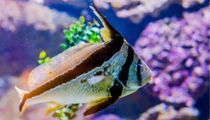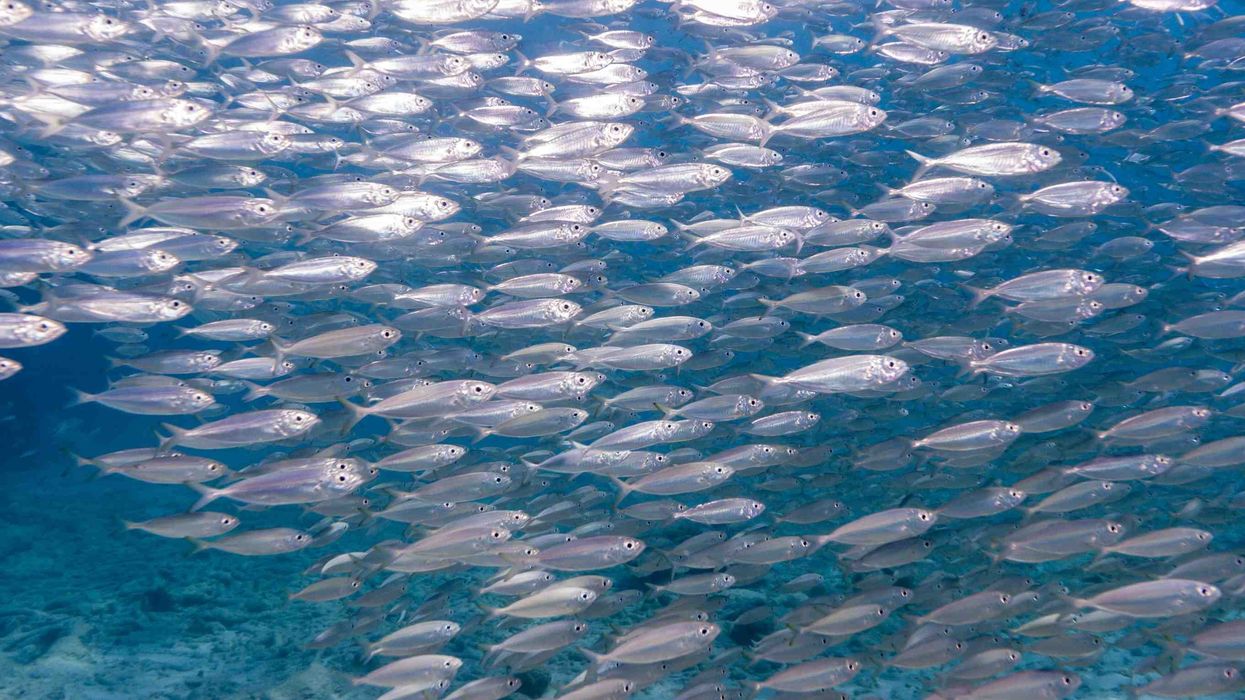Are you searching for cute little marine fish for your aquarium? Then here comes a tip for your search. A cute little aquarium fish that will make your life more enjoyable.
This beautiful fish is known for its shape as a jackknife. They have a silvery body marked by a pair of black stripes across the face.
A similarly colored stripe runs down from the tip of the tail fin to the tail. The mixture of the two fins resembles a jackknife, giving it the typical name. They are also shy and graceful saltwater small fish, hence require a peaceful environment with a sandy bottom and lots of rocks to hide.
The coloration might also cover the eyes, so predators cannot tell where the fish is looking and even confuse the predators into thinking it’s not even a fish. They will consume crustaceans and other motile invertebrates within the reef aquarium. Most of these jackknife fish are marine fish whose food is worms.
Discover more amazing animals with spiny dogfish facts and catfish facts!
Jackknife Fish Interesting Facts
What type of animal is a jackknife fish?
The jackknife fish (Equetus lanceolatus) may be found mainly within the Atlantic and Caribbean islands. It's a marine fish.
What class of animal does a jackknife fish belong to?
The jackknife fish (Equetus lanceolatus) belongs to the Actinopterygii class. They take advantage of reef inhabitants like ornamental shrimp, worms, and even other small reef fishes. Due to this, it’s safe to say that they're carnivorous feeders.
How many jackknife fish are there in the world?
Although the exact population of this small fish is not estimated, we can find ten species in four genera. Therefore, it is safe to assume that this unique shaped fish will be significant considering the vast distribution in the Atlantic Ocean and Caribbean Islands.
Where does a jackknife fish live?
Jackknife fish (Equetus lanceolatus) are primarily found in the oceans. This marine fish is mainly found along the coasts in water up to 196.9 ft (60 m) deep.
This shaped fish is also called Caribbean reef fish, as they are found in the Caribbean islands, Bahamas, Florida, and the Gulf of Mexico. The jackknife fishes are commercial fishes as many fish lovers search for such kinds of fishes for their school of an aquarium.
What is a jackknife fish's habitat?
Jackknife fish (Equetus lanceolatus) is mainly found along the coasts. This jackknife fish could be a reef-safe fish, and that they are a beautiful fish for only a saltwater aquarium.
It's found along with the corals and reef parts of the ocean. This jackknife fish could be found in the western Atlantic Ocean, along the eastern coasts of the Americas from the Carolinas of the U.S to Brazil, including the Caribbeans.
Who does jackknife fish live with?
These fishes require a calm community in a 125 gallon (613.7 l) aquarium with live rocks that can be used as hiding places or also as a supplemental food source with a sandy bottom. It tends to hide in the rocks present in the aquarium until it feels secure.
How long does a jackknife fish live?
The lifespan of this is not accurately known.
How do they reproduce?
These fish produce croaking and drumming sounds to attract their opposites and progress with mating. The eggs produced will be hidden behind the caves, and when eggs mature and hatch, they become larvae and turn into tiny juveniles further.
What is their conservation status?
This fish species is not considered to be threatened and hence are under the Least Concern category of IUCN. However, it has a wide distribution, and in many areas, it is a common species.
Jackknife Fish Fun Facts
What do jackknife fish look like?

It is small with black and silvery stripes that belong to the Sciaenidae family of the drums category. Its elongated fin with a black band that runs from the tip of the fin to the top of the tail helps to identify this exotic-looking fish.
They're odd-shaped fish and have considerably long dorsal and caudal fins. Dorsal fins at the front get smaller as these fishes age.
How cute are they?
These fishes are adorable with their distinct caudal fins. However, it is shy and has many hiding spots in caves and crevices from well-established live rock.
How do they communicate?
The jackknife can produce drumming or croaking sounds. It involves the fish pounding its abdominal muscles on its air bladder. This behavior could be related to mating or can be due to low-level aggression and keeping involved with one another in turbid waters.
How big is a jackknife fish?
The jackknife fish is a pretty small fish starting from about 5-9 in (12.7-22.9 cm). However, it is considered to be two times bigger than Japanese anchovies.
How fast can a jackknife fish move?
Jackknife likes to play hide and seek from its predators (mainly humans) by hiding itself in between corals and reefs moving faster.
How much does a jackknife fish weigh?
The weight of this species has not been estimated accurately.
What are the male and female names of the species?
There are no particular names given for the male and female species.
What would you call a baby jackknife fish?
Mostly baby of this fish is called a juvenile. These juveniles eat food like plankton and graduate to small crabs and shrimp.
What do they eat?
This species may consume crustaceans and other motile invertebrates within the reef aquarium as their food. Regular meals comprise a range of things like black worms and Artemia salina.
They comb the live rock, searching for worms, crustaceans, and tiny reef fish if it's hungry. Like the lionfish, jackknives are also considered 100% reef safe. These species may eat any shrimp, but they will not bother corals or anemones.
Are they poisonous?
These fishes have spines or stinging cells that will be toxic or harmful to people. Therefore, one must be cautious while handling these animals and always be kept aloof from children or uninformed individuals. In addition, the captive-bred species have reports of ciguatera poisoning.
Would they make a good pet?
Jackknife fish may be a shy aquarium fish and desires many hiding spots within caves and crevices from well-established live rock. This fish is commonly found within the home aquarium, like many other marine species, but it's a noteworthy and graceful fish. Thanks to its incredible shape and delightful stripes, it'll make a decent pet for fish lovers.
Did you know...
Did you recognize that these jackknife fin fishes have dark lines that run through the eyes may serve to cover the eyes so other animals cannot tell where the fish is looking or maybe if it's a fish?
Do they bite?
These beautiful cute fishes with their caudal fins are reef-safe ones with specific cautions. Though the foods they eat are worms and shrimp, they don't bite unless disturbed. Instead, they hide behind the corals and tend to attack unknown predators.
Do humans eat them?
No. These fishes don't seem to be edible. They're mainly used as aquarium fish. They are primarily captive-bred animals. Spotted drums and jackknives seem very liable to shipping stress, making them difficult fishes to get.
Here at Kidadl, we have carefully created lots of interesting family-friendly animal facts for everyone to discover! Learn more about some other fish from our swai fish facts and skate fish facts pages.
You can even occupy yourself at home by coloring in one of our free printable Jackknife fish coloring pages.









